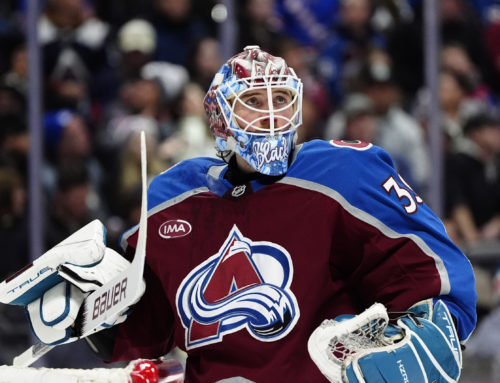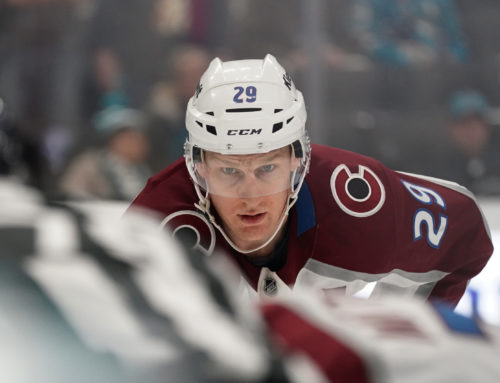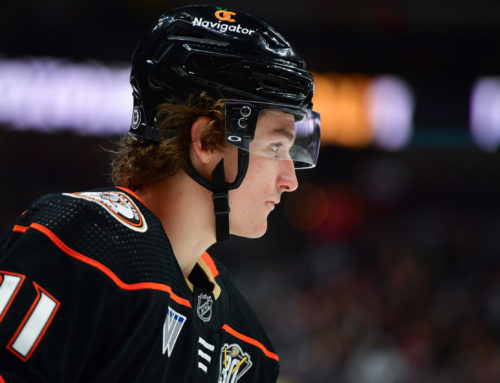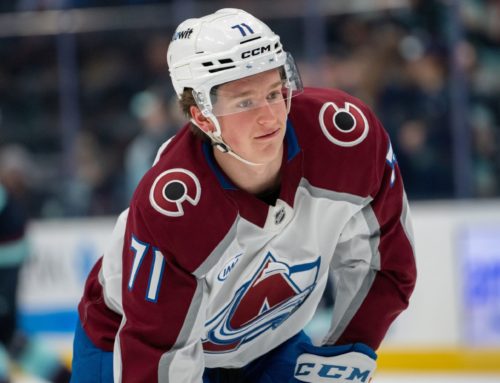Western Conference – Playoff Teams (Pacific Division)
Doran Libin
2016-04-04

Preview Time! Gearing up for playoff pools, we take a look at the key players of the Pacific Division…
As the regular season wraps up it is time to preview the teams that have qualified for the playoffs. The preview this year will be divided by the division in which each team will likely play their games. Thus Nashville as the better wildcard team will be featured this week in the Pacific Division. The players are listed with their most common recent linemates and their career regular season and playoff point per game averages. The career averages can skew the results a little but for the most part they will show which players have a knack for stepping up in the playoffs and which players fall off their normal rates of production.
Anaheim
Forwards
|
Player |
Season |
P/O |
Player |
Season |
P/O |
Player |
Season |
P/O |
|
0.42 |
0.47 |
0.60 |
0.70 |
0.45 |
0.59 |
|||
|
0.48 |
N/A |
0.95 |
0.97 |
0.55 |
0.30 |
|||
|
0.82 |
0.82 |
0.47 |
0.15 |
0.38 |
0.21 |
|||
|
0.30 |
0.50 |
0.51 |
0.71 |
0.21 |
0.29 |
|||
|
Nick Ritchie |
0.06 |
N/A |
0.34 |
0.25 |
0.58 |
0.42 |
Defense
|
Player |
Season |
P/O |
Player |
Season |
P/O |
|
0.43 |
0.50 |
0.38 |
0.35 |
||
|
Josh Manson |
0.19 |
N/A |
0.40 |
0.44 |
|
|
0.51 |
0.57 |
0.13 |
0.17 |
||
|
0.41 |
N/A |
0.23 |
0.32 |
||
|
0.15 |
N/A |
|
|
|
This is one of the deepest teams in the playoffs. The forwards feature eleven legitimate top nine forwards with Santorelli unable to even make the lineup on a regular basis and David Perron injured for the time being. It will be tough for Ryan Kesler and Jakob Silfverberg to repeat last year’s heroics as they are being as even more of a defensive shutdown line. That being the case Kesler has averaged nearly a point per game over the last three months and Silfverberg has come along with him in two of those months. Should they manage to repeat last year’s heroics it will be in the face of a massive zone start deficit. Getzlaf and Perry are known commodities both during the regular season and during the playoffs and can be counted to continue to produce well in the playoffs. If there is a sleeper on this Ducks team it is Rickard Rakell as he returns from injury and should reunite with Corey Perry on the second line. Rakell’s production has spiked in a big way since being placed on a line with Perry and there is no reason to think that it will not continue.
There are two defensemen to focus on for the Ducks, Cam Fowler and Sami Vatanen. They receive by far the most power play time amongst Ducks defensemen. Hampus Lindholm has between 10 and 20 minutes less than them on the season despite having played five more games than Vatanen and 10 more than Fowler. Vatanen, when healthy, is the better option as he gets used in a more offensive capacity and produces on the power play at a higher rate. He also does not have Kevin Bieksa anchored to him at even strength as Fowler does. Beyond Fowler and Vatanen there is little to choose from. Lindholm is solid but unexceptional and clearly the number defenseman on the team, and as more of a two-way defenseman gets second unit power play minutes. The only other enticing option is Shea Theodore as he has the offensive chops to contribute but it is highly questionable whether he even sees the ice in the playoffs, especially after getting sent to the AHL this weekend.
Los Angeles
Forwards
|
Player |
Season |
P/O |
Player |
Season |
P/O |
Player |
Season |
P/O |
|
0.61 |
0.64 |
0.73 |
0.65 |
0.61 |
0.53 |
|||
|
0.53 |
0.59 |
0.89 |
0.60 |
0.40 |
0.48 |
|||
|
0.33 |
0.22 |
0.79 |
0.77 |
0.21 |
0.30 |
|||
|
0.17 |
0.30 |
Andy Andreoff |
0.14 |
N/A |
0.57 |
0.50 |
||
|
0.14 |
0.07 |
Nick Shore |
0.17 |
N/A |
0.84 |
0.71 |
||
|
|
|
|
Nic Dowd |
0.00 |
N/A |
|
|
|
Defense
|
Player |
Season |
P/O |
Player |
Season |
P/O |
|
0.52 |
0.66 |
0.24 |
N/A |
||
|
0.42 |
0.35 |
0.32 |
0.27 |
||
|
0.23 |
0.14 |
Rob Scuderi |
0.14 |
0.12 |
|
|
0.32 |
N/A |
Derek Forbort |
0.14 |
N/A |
While Dustin Brown has a history of being a playoff performer it is hard to envision him playing in the top six over Kris Versteeg and Marian Gaborik. Versteeg has not had much success since being traded to the Kings but he has had success in the playoffs, just not recently. The problem with betting on a King who is not certain to play in the top six is that there is little talent, or production, to be found in the bottom six. There are only four sure things in the Kings’ top six and they should be taken early by anyone picking the Kings to go deep. Do not buy in too much into Vincent Lecavalier as his production with the Kings has come largely on the second unit power play where he has averaged almost six points per 60 minutes. With power plays in the playoffs becoming even more of a rarity than during the regular season betting on a player who derives the vast majority of his points from second unit power play time is a high risk gamble, The best bets amongst the possible top six forwards are Versteeg and Tanner Pearson as Dustin Brown has been used more often in a bottom six role during the season.
Drew Doughty is an elite defenseman but during the regular he does not quite deliver elite fantasy point production. That seems to change as the games get bigger as his production jumps in the playoffs and he showed the same during the 2014 Olympics. In fact he has the third highest point per game pace amongst active defensemen with more than 20 playoffs games. If you believe that the Kings will go deep he is as good a bet as almost any forward. Muzzin should also be a good bet as his production was much closer to what has come to be expected from him in his second playoffs than his first, no doubt closely linked to his finally receiving more than 20 minutes per game that year.
Nashville
Forwards
|
Player |
Season |
P/O |
Player |
Season |
P/O |
Player |
Season |
P/O |
|
0.34 |
0.33 |
0.64 |
1.00 |
0.73 |
0.61 |
|||
|
0.72 |
1.00 |
0.75 |
0.58 |
0.50 |
0.75 |
|||
|
Viktor Arvidsson |
0.27 |
N/A |
0.53 |
0.40 |
0.47 |
0.37 |
||
|
0.32 |
0.19 |
Colton Sissons |
0.20 |
N/A |
Mikka Salomaki |
0.18 |
N/A |
|
|
0.18 |
N/A |
0.08 |
0.25 |
0.32 |
0.33 |
|||
|
0.21 |
0.31 |
|
|
|
|
|
|
Defense
|
Player |
Season |
P/O |
Player |
Season |
P/O |
|
0.60 |
0.47 |
0.56 |
0.06 |
||
|
0.37 |
0.33 |
0.27 |
0.17 |
||
|
0.21 |
0.18 |
Petter Granberg |
0.06 |
N/A |
|
|
0.29 |
N/A |
Anthony Bitetto |
0.18 |
N/A |
The Predators have three lines of legitimate top nine players and a fourth line that gets buried under extreme defensive zone starts. That fourth allows Mike Ribeiro to start a ridiculous percentage of his shifts in the offensive zone, it has been known to reach 80%. That makes that line a slightly better play than the Johansen line as they produce shots and goals at a higher rate at even strength. Before Jimmy Vesey declined to sign with the Predators he would have been the ultimate playoff sleeper as he was rumoured to have been all but promised a spot in the top six, likely with Johansen and Neal. The biggest beneficiary of Vesey’s decision is Calle Jarnkrok as there is a huge difference between playing on the top two lines and the third line. Colin Wilson is the best example of this as the he is on the less for approximately one goal less per 60 minutes when he is in the top six. Just by being in the top six Jarnkrok averages two extra points every seven games, making him a decent depth option.
The top two pairings of the Nashville defense corps eat up nearly 48 minutes per game since the Seth Jones trade, and that number could easily rise above 50 in the playoffs. As Weber and Josi are already going to be very high on anyone’s list who has the Predators going far the value to be found here is in Ekholm and Ellis. Both are capable of putting up a point every two games as they both play more than 20 minutes per game and get power play minutes. Ekholm in particular has been the big winner after the Seth Jones trade having nearly doubled his first half point totals in the second half of the season.
San Jose
Forwards
|
Player |
Season |
P/O |
Player |
Season |
P/O |
Player |
Season |
P/O |
|
0.51 |
0.71 |
0.98 |
0.76 |
0.79 |
0.69 |
|||
|
0.48 |
N/A |
0.75 |
0.64 |
0.44 |
0.66 |
|||
|
0.36 |
N/A |
0.73 |
.70 |
0.38 |
0.26 |
|||
|
0.28 |
0.33 |
0.34 |
N/A |
0.46 |
0.38 |
|||
|
0.33 |
0.71 |
0.07 |
0 |
0.25 |
0.33 |
Defense
|
Player |
Season |
P/O |
Player |
Season |
P/O |
|
0.53 |
0.35 |
0.38 |
0.47 |
||
|
0.16 |
0 |
0.19 |
0.04 |
||
|
0.25 |
0.13 |
M.E. Vlasic |
0.31 |
0.17 |
|
|
Dylan Demelo |
0.10 |
N/A |
Matt Tennyson |
0.23 |
N/A |
The Sharks and Predators are both going to be in tough in the first round against two of favourites to win the Stanley Cup in Anaheim and Los Angeles. The Sharks feature a big time playoff performer in Joel Ward as his production rate goes up by 50% during the playoffs. Ward has only failed to average at least a point every two games in one of his five career playoff runs. He should have no problem hitting the half point per game mark this year and is a good Sharks sleeper pick. Patrick Marleau is a good player to avoid on the Sharks as he has been massively hurt by Logan Couture’s return. When he is on the ice with Melker Karlsson and Tommy Wingels the Sharks score less a goal per 60 minute, as opposed to the nearly two goals per 60 minute the Sharks score when he plays with Joel Ward. Also keep an eye on Tomas Hertl as almost 67% of his points have come in the second half, with almost all of those points coming at eveb strength. That change in his production rate marks Hertl’s move from third line center to first line winger and he should be drafted based on his second half production.
There is a massive drop-off in fantasy value on the Sharks’ defense corps once Brent Burns is off the board. Burns is an absolute fantasy monster during the regular season, especially this year where he still has an outside shot at 30 goals. A third of Burns’ points have come from the power play, which is not outrageous for a defensemen producing at nearly a point per game pace. Vlasic is another intriguing option, despite the injury, but his production this was something of an outlier based on the rest of his career despite little change to the way he was being used. As Vlasic’s production was largely the result of an unusually high IPP and an on-ice shooting percentage of 11% it is probably best to avoid Sharks’ defensemen no named Burns until the very late rounds.





 DET
DET MTL
MTL NYR
NYR PHI
PHI CAR
CAR CBJ
CBJ BOS
BOS OTT
OTT MIN
MIN UTA
UTA STL
STL VGK
VGK CGY
CGY BUF
BUF EDM
EDM VAN
VAN ANA
ANA PIT
PIT SEA
SEA WSH
WSH S.J
S.J NSH
NSH FLA
FLA N.J
N.J L.A
L.A
